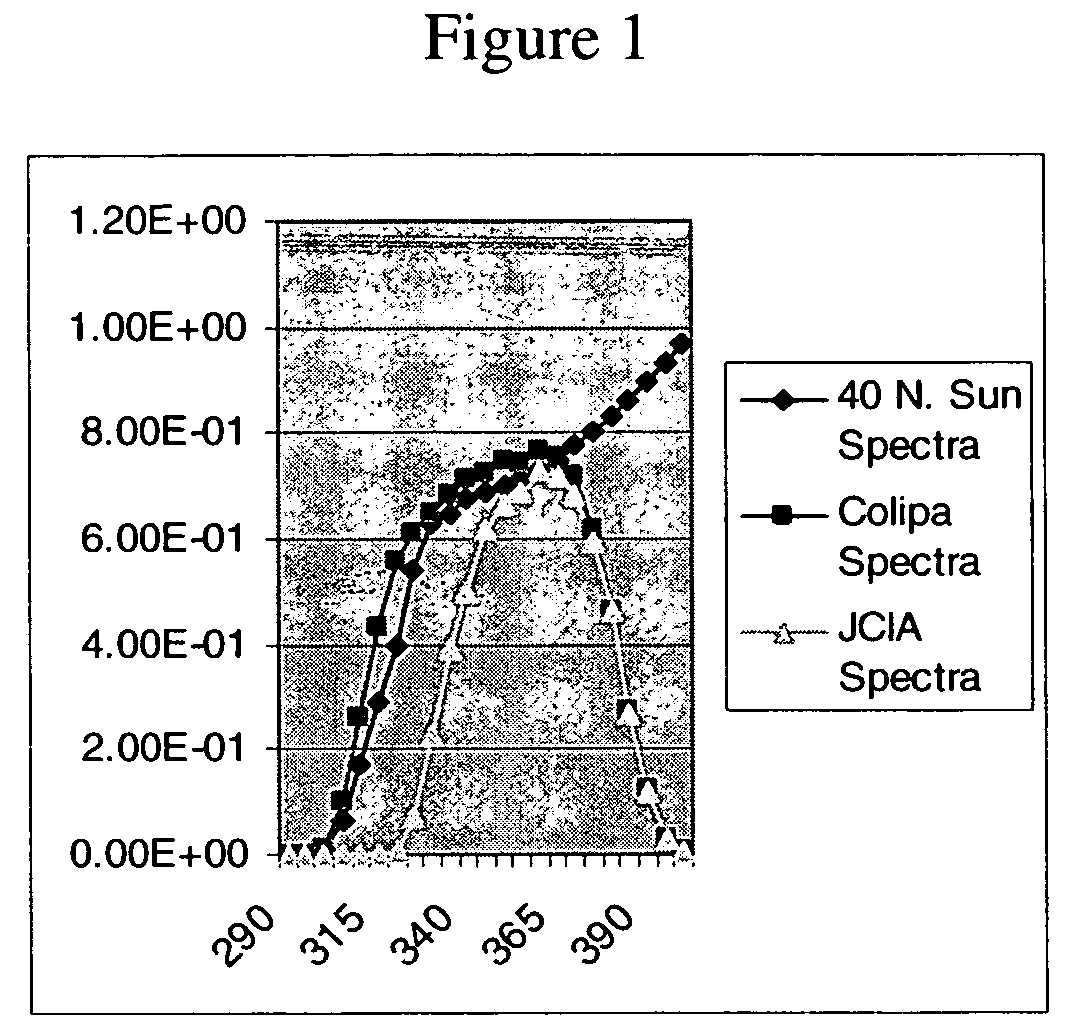Natural sunlight photostable composition
a composition and natural sunlight technology, applied in the field of photostable compositions, can solve the problems of misleading consumers to believe they can safely stay out in the sun for longer periods of time, spf methodology does not satisfactorily provide an accurate measure of how the formulation will perform, and affect the photostability of triplet sunscreens. , to achieve the effect of accurately communicating the amount of uvr photoprotection actually provided, minimizing the amount of potential harmful free radicals, and reducing the effect o
- Summary
- Abstract
- Description
- Claims
- Application Information
AI Technical Summary
Benefits of technology
Problems solved by technology
Method used
Image
Examples
example 1
Sunscreen Comparison
[0046]Formulation 1, a photostable sunscreen composition with an SPF of 50, was prepared according to the procedure set forth below.
[0047]
Formula 1*Formula 2Formula 3(Invention)(Comparison)(Comparison)Phase AOzokerite999Beeswax666Candelilla Wax444Paraffin999Octocrylene101.610Oxybenzone666Aloe Extract0.08230.10.1Homosalate—1515Octisalate—55Octinoxate—7.57.5Caprylic / Capric996.8TriglyceridesDiisobutyl Adipate1565Silica221.5Flora / Nut Extracts0.10.10.1Vitamins A, C & E0.010.010.01Propylparaben0.10.10.1BHT0.010.010.01Hexacaprylate / 14.5842.88HexacaprateVitamin E0.00154——Mineral Oil0.00123——Avobenzone322Phase BFragrance0.11462——Cyclomethicone1213.5810*Unless otherwise stated, percentages are weight / weight.
With the exception of the avobenzone, combine the ingredients of Phase A and mix until uniform. Add avobenzone. Continue mixing at about 75° C. until a uniform fluid mixture is obtained. Cool while stirring. At about 50° C. add the Phase B ingredients. Continue mixing a...
example 2
Sunscreen Comparison
[0056]The trio of sunscreens of the present invention—octocrylene, oxybenzone and avobenzone—were combined in a prior art sunscreen formulation in the following weight / weight ratios: 10% octocrylene, 6% oxybenzone, 3% avobenzone and 5% octisalate. Two formulations, the trio sunscreens of the present invention (Formula 4) and the prior art quartet of sunscreens (Formula 5), were prepared according to the procedure set forth below.
[0057]
Formula 4Formula5IngredientIngredients(Invention)(Prior art)FunctionPhase AMicrocrystalline Wax0.50.5ThickenerPolyethylene, Stearoxy0.50.5ThickenerDimethiconeBeeswax0.50.5ThickenerCetyl Dimethicone0.50.5SolventOxybenzone6.06.0SunscreenOctocrylene10.010.0SunscreenOctisalate—5.0SunscreenDisopropyl Adipate5.05.0Solvent / Spreading AgentDimethyl Capramide2.02.0SolventSpreading AgentCetyl Dimethicone3.03.0EmulsifierCopolyolEthylhexyl Palmitate5.05.0Spreading agentMethylparaben0.30.3PreservativePropylparaben0.10.1PreservativePhase A-1Avoben...
PUM
| Property | Measurement | Unit |
|---|---|---|
| wavelength | aaaaa | aaaaa |
| wavelengths | aaaaa | aaaaa |
| wavelengths | aaaaa | aaaaa |
Abstract
Description
Claims
Application Information
 Login to View More
Login to View More - R&D
- Intellectual Property
- Life Sciences
- Materials
- Tech Scout
- Unparalleled Data Quality
- Higher Quality Content
- 60% Fewer Hallucinations
Browse by: Latest US Patents, China's latest patents, Technical Efficacy Thesaurus, Application Domain, Technology Topic, Popular Technical Reports.
© 2025 PatSnap. All rights reserved.Legal|Privacy policy|Modern Slavery Act Transparency Statement|Sitemap|About US| Contact US: help@patsnap.com

